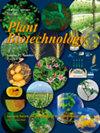缺α-葡聚糖水二激酶1基因的马铃薯突变体块茎淀粉的特性[lt;i>GWD1</i>]使用CRISPR/dMac3-Cas9系统进行靶向诱变
IF 1.1
4区 生物学
Q4 BIOTECHNOLOGY & APPLIED MICROBIOLOGY
引用次数: 1
摘要
淀粉中的葡萄糖链被磷酸化并有助于结构稳定。淀粉中含有的磷酸基团也起着保持水分的作用。α-葡聚糖水二激酶1 (GWD1)参与淀粉中葡萄糖链的磷酸化。在本研究中,我们使用CRISPR/dMac3-Cas9系统生成了GWD1基因的马铃薯突变体。对gwd1缺陷突变体的表型观察揭示了它们在块茎淀粉形成中的生理作用。4个等位基因突变体表现出生长迟缓和块茎形成延迟。gwd1突变体块茎淀粉中磷含量显著降低。该突变体淀粉的直链淀粉含量高于野生型淀粉,而其糊化温度略低于野生型淀粉。突变体淀粉的峰值粘度低于WT淀粉。这些观察结果表明,与WT、she3和gbss1突变体淀粉相比,gwd1突变体的淀粉具有独特的特性。测定了gwd1突变体块茎经冻融处理后的组织释放水量,并与WT和其他突变体进行了比较。gwd1、sbe3和gbss1突变体块茎的失水量明显低于WT。研究结果表明,GWD1基因不仅对马铃薯生长有重要影响,而且对薯类淀粉的性状也有很大影响。本文章由计算机程序翻译,如有差异,请以英文原文为准。
Peculiar properties of tuber starch in a potato mutant lacking the α-glucan water dikinase 1 gene <i>GWD1</i> created by targeted mutagenesis using the CRISPR/dMac3-Cas9 system
Glucose chains in starch are phosphorylated and contribute to structural stabilization. Phosphate groups contained in starch also play a role in retaining moisture. α-Glucan water dikinase 1 (GWD1) is involved in the phosphorylation of glucose chains in starch. In this study, we generated potato mutants of the GWD1 gene using the CRISPR/dMac3-Cas9 system. Observation of the phenotypes of the GWD1-deficient mutants revealed their physiological roles in tuber starch formation. The 4-allele mutants showed growth retardation and a delay in tuber formation. A significant decrease in phosphorus content was detected in the tuber starch of the gwd1 mutant. This mutant starch showed a higher amylose content than the wild-type starch, whereas its gelatinization temperature was slightly lower than that of the WT starch. The peak viscosity of the mutant starch was lower than that of the WT starch. These observations revealed that the starch of the gwd1 mutants had peculiar and unique properties compared to those of WT, sbe3 and gbss1 mutant starches. The amount of tissue-released water due to freeze–thawing treatment was determined on tubers of the gwd1 mutant and compared with those of WT and the other mutants. Significantly less water loss was found in the gwd1, sbe3 and gbss1 mutant tubers than in the WT tubers. Our results indicate that the GWD1 gene is not only important for potato growth, but also largely effective for the traits of tuber starch.
求助全文
通过发布文献求助,成功后即可免费获取论文全文。
去求助
来源期刊

Plant Biotechnology
BIOTECHNOLOGY & APPLIED MICROBIOLOGY-PLANT SCIENCES
CiteScore
2.90
自引率
18.80%
发文量
45
审稿时长
6-12 weeks
期刊介绍:
Plant Biotechnology is an international, open-access, and online journal, published every three months by the Japanese Society for Plant Biotechnology. The journal, first published in 1984 as the predecessor journal, “Plant Tissue Culture Letters” and became its present form in 1997 when the society name was renamed to Japanese Society for Plant Cell and Molecular Biology, publishes findings in the areas from basic- to application research of plant biotechnology. The aim of Plant Biotechnology is to publish original and high-impact papers, in the most rapid turnaround time for reviewing, on the plant biotechnology including tissue culture, production of specialized metabolites, transgenic technology, and genome editing technology, and also on the related research fields including molecular biology, cell biology, genetics, plant breeding, plant physiology and biochemistry, metabolic engineering, synthetic biology, and bioinformatics.
 求助内容:
求助内容: 应助结果提醒方式:
应助结果提醒方式:


